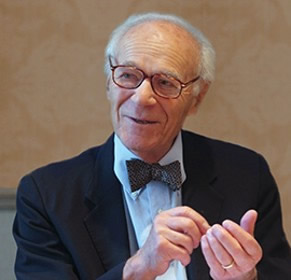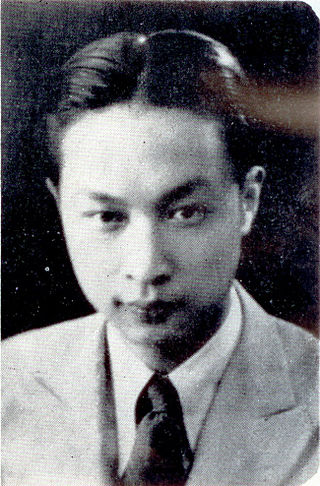Related Research Articles

James Joseph Heckman is a Nobel Prize-winning American economist at the University of Chicago, where he is The Henry Schultz Distinguished Service Professor in Economics and the College; Professor at the Harris School of Public Policy; Director of the Center for the Economics of Human Development (CEHD); and Co-Director of Human Capital and Economic Opportunity (HCEO) Global Working Group. He is also Professor of Law at the Law School, a senior research fellow at the American Bar Foundation, and a research associate at the National Bureau of Economic Research. In 2000, Heckman shared the Nobel Memorial Prize in Economic Sciences with Daniel McFadden, for his pioneering work in econometrics and microeconomics. As of December 2020, according to RePEc, he is the second-most influential economist in the world.

Lawrence Robert Klein was an American economist. For his work in creating computer models to forecast economic trends in the field of econometrics in the Department of Economics at the University of Pennsylvania, he was awarded the Nobel Memorial Prize in Economic Sciences in 1980 specifically "for the creation of econometric models and their application to the analysis of economic fluctuations and economic policies." Due to his efforts, such models have become widespread among economists. Harvard University professor Martin Feldstein told the Wall Street Journal that Klein "was the first to create the statistical models that embodied Keynesian economics," tools still used by the Federal Reserve Bank and other central banks.
The Chicago school of economics is a neoclassical school of economic thought associated with the work of the faculty at the University of Chicago, some of whom have constructed and popularized its principles. Milton Friedman and George Stigler are considered the leading scholars of the Chicago school.
Agricultural economics is an applied field of economics concerned with the application of economic theory in optimizing the production and distribution of food and fiber products. Agricultural economics began as a branch of economics that specifically dealt with land usage. It focused on maximizing the crop yield while maintaining a good soil ecosystem. Throughout the 20th century the discipline expanded and the current scope of the discipline is much broader. Agricultural economics today includes a variety of applied areas, having considerable overlap with conventional economics. Agricultural economists have made substantial contributions to research in economics, econometrics, development economics, and environmental economics. Agricultural economics influences food policy, agricultural policy, and environmental policy.

Theodore William Schultz was an American Agricultural economist and chairman of the University of Chicago Department of Economics. Schultz rose to national prominence after winning the 1979 Nobel Memorial Prize in Economic Sciences.

Fritz Machlup was an Austrian-American economist who was president of the International Economic Association from 1971–1974. He was one of the first economists to examine knowledge as an economic resource, and is credited with popularizing the concept of the information society.

Colin Grant Clark was a British and Australian economist and statistician who worked in both the United Kingdom and Australia. He pioneered the use of gross national product (GNP) as the basis for studying national economies.
Hirsh Zvi Griliches was an economist at Harvard University. The works by Zvi Griliches mostly concerned the economics of technological change, including empirical studies of diffusion of innovations and the role of R & D, patents, and education.
Arnold Carl Harberger is an American economist. His approach to the teaching and practice of economics is to emphasize the use of analytical tools that are directly applicable to real-world issues. His influence on academic economics is reflected in part by the widespread use of the term "Harberger triangle" to refer to the standard graphical depiction of the efficiency cost of distortions of competitive equilibrium. His influence on the practice of economic policy is manifested by the high positions attained by his followers in national agencies such as central banks and ministries of finance, and in international agencies such as the World Bank.
Applied economics is the study as regards the application of economic theory and econometrics in specific settings. As one of the two sets of fields of economics, it is typically characterized by the application of the core, i.e. economic theory and econometrics to address practical issues in a range of fields including demographic economics, labour economics, business economics, industrial organization, agricultural economics, development economics, education economics, engineering economics, financial economics, health economics, monetary economics, public economics, and economic history. From the perspective of economic development, the purpose of applied economics is to enhance the quality of business practices and national policy making.

Leonid Hurwicz was a Polish-American economist and mathematician, known for his work in game theory and mechanism design. He originated the concept of incentive compatibility, and showed how desired outcomes can be achieved by using incentive compatible mechanism design. Hurwicz shared the 2007 Nobel Memorial Prize in Economic Sciences for his seminal work on mechanism design. Hurwicz was one of the oldest Nobel Laureates, having received the prize at the age of 90.
Bagicha Singh Minhas (1929-2005) is an Indian economist.
Pietro Balestra was a Swiss economist specializing in econometrics. He was born in Lugano and earned a B.A. in economics from the University of Fribourg. Balestra moved for graduate work to the University of Kansas and Stanford University. He was awarded the Ph.D. in Economics by Stanford University in 1965.
David Gale Johnson was an American economist and an expert on Russia and China. Among other notable contributions to economics, Johnson concluded that the strength of an industry depends on how the market works and not so much on government actions. Johnson was Chairman of the department of economics at the University of Chicago and a member of the National Academy of Sciences. He was also a fellow of the American Agricultural Economics Association and the American Academy of Arts and Sciences. The New York Times called him "a pioneer in agricultural economics". The University of Chicago called him "one of the world's most eminent researchers of agricultural and development economics". The National Academies Press called him "a scholar of exceptional breadth who made original and important contributions to economics and to public policy".

Michael Patrick Keane is an American/Australian economist who is currently professor of economics and Australian Research Council laureate fellow at the University of New South Wales. From 2012 to 2017 he was the Nuffield Professor of Economics at the University of Oxford and a professorial fellow of Nuffield College. He is considered one of the world's leading experts in the fields of Choice Modelling, structural modelling, simulation estimation, and panel data econometrics.

Guido Wilhelmus Imbens is a Dutch-American economist whose research concerns econometrics and statistics. He holds the Applied Econometrics Professorship in Economics at the Stanford Graduate School of Business at Stanford University, where he has taught since 2012.

Ta-Chung Liu was a Chinese American economist and econometrician. He was a professor of economics at Johns Hopkins University and Cornell University. During his time at Cornell, he mentored Robert F. Engle, an econometrician who later won the Nobel Prize in Economics.
Charles Frederick Roos was an American economist who made contributions to mathematical economics. He was one of the founders of the Econometric Society together with American economist Irving Fisher and Norwegian economist Ragnar Frisch in 1930. He served as Secretary-Treasurer during the first year of the Society and was elected as President in 1948. He was director of research of the Cowles Commission from September 1934 to January 1937.
Francis X. Diebold is an American economist known for his work in predictive econometric modeling, financial econometrics, and macroeconometrics. He earned both his B.S. and Ph.D. degrees at the University of Pennsylvania, where his doctoral committee included Marc Nerlove, Lawrence Klein, and Peter Pauly. He has spent most of his career at Penn, where he has mentored approximately 75 Ph.D. students. Presently he is Paul F. and Warren S. Miller Professor of Social Sciences and Professor of Economics at Penn’s School of Arts and Sciences, and Professor of Finance and Professor of Statistics at Penn’s Wharton School. He is also a Faculty Research Associate at the National Bureau of Economic Research in Cambridge, Massachusetts, and author of the No Hesitations blog.
Hans P. Binswanger-Mkhize was a Swiss economist. His research focused mainly on agricultural economics in developing countries.
References
- ↑ "Marc L Nerlove". University of Maryland College of Agriculture & Natural Resources. Retrieved 2022-11-14.
- ↑ "Marc Nerlove, Clark Medalist 1969". American Economic Association. 1969. Retrieved 2022-11-14.
- ↑ "John Bates Clark Medal". American Economic Association. Retrieved 2022-11-14.
- ↑ "Marc Nerlove, Distinguished Fellow 2012". American Economic Association. 2012. Retrieved 2022-11-14.
- ↑ Dupont-Kieffer, Ariane; Pirotte, Alain (2011). "The Early Years of Panel Data Econometrics". History of Political Economy. 43 (Suppl 1): 258–282. doi:10.1215/00182702-1158754.
- ↑ Weston, J. Fred; Jacoby, N.; Hirshleifer, Jack (1975). "Samuel H. Nerlove, Management, Los Angeles". University of California, In Memoriam. University of California. pp. 110–112.
- 1 2 Ghysels, Eric; Nerlove, Marc (March 1993). "The ET Interview: Professor Marc Nerlove". Econometric Theory. 9 (1): 119. doi:10.1017/S0266466600007386. JSTOR 3532008. S2CID 121165463.
- ↑ Peart, Andrew (2019). "University of Chicago Obituaries". University of Chicago Magazine. 111 (3). Retrieved 2022-11-14.
- ↑ Nerlove, Sara. "Sara Nerlove". LinkedIn. Retrieved 2022-11-14.
- ↑ "Death Notice: Mary Ellen Nerlove". Chicago Tribune. 7 August 2011. p. 37. Retrieved 2022-11-14.
- ↑ Nerlove, Evelyn; Nerlove, Miriam (1985). Who Is David?: A Story of an Adopted Adolescent and His Friends. New York City: Child Welfare League of America.
- ↑ Nerlove, Marc (1955). The Predictive Test as a Tool for Research: The Demand for Meat in the United States (MA). The Johns Hopkins University.
- ↑ Nerlove, Marc (1956). Estimates of the Elasticities of Supply of Corn, Cotton, and Wheat (PhD). The Johns Hopkins University.
- ↑ Nerlove, Marc (1958). The Dynamics of Supply: Estimation of Farmers' Response to Price. The Johns Hopkins University Studies in Historical and Political Science, ser. 76, no. 2. Baltimore: The Johns Hopkins University Press.
- ↑ Qin, Duo (1993). The Formation of Econometrics: A Historical Perspective. New York: Oxford University Press. p. 164. ISBN 978-0-19-829287-6.
- ↑ "People Section". Agricultural & Applied Economics Association Newsletter. 38. 2016. Retrieved 2022-11-14.
- ↑ "Marc L. Nerlove". IZA Institute of Labor Economics. Retrieved 2022-11-14.
- ↑ Marc L. Nerlove papers, 1930-2014, bulk dates 1947-2014. David M. Rubenstein Rare Book and Manuscript Library, Duke University.
- ↑ United States, President's Committee to Appraise Employment and Unemployment Statistics (1962). Measuring Employment and Unemployment. Washington: U.S. Government Printing Office. p. 5.
- ↑ "Past Officers & Council". The Econometric Society. Retrieved 2022-11-14.
- ↑ "Past Members of the Executive Committee". American Economic Association. Retrieved 2022-11-14.
- ↑ United States, Library of Congress, Congressional Research Service, Science Policy Research Division (1977). The Psychological and Social Sciences Research Support Programs of the National Science Foundation: A Background Report (PDF). Washington: U.S. Government Printing Office. p. 42.
- ↑ "Marc Nerlove". Fulbright Scholar Program. Retrieved 2022-11-14.
- ↑ "Marc Nerlove". John Simon Guggenheim Foundation. Retrieved 2022-11-14.
- ↑ "Previous AAEA Fellows". Agricultural & Applied Economics Association. Retrieved 2022-11-14.